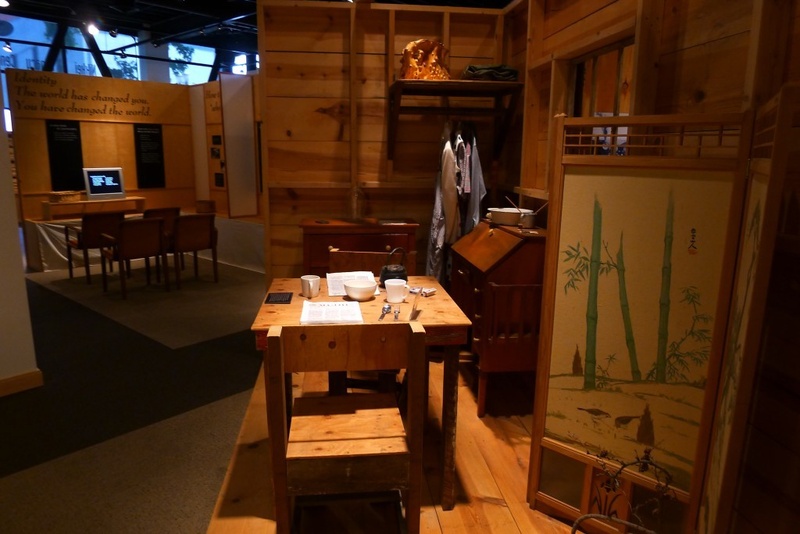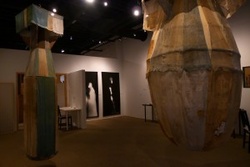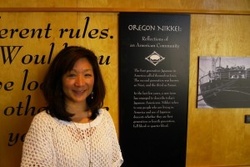I visited the Oregon Nikkei Legacy Center in Portland, Oregon last week while on a business trip to the northwest, and I was struck at how important organizations like it, and the museum it operates are for our community.
Institutions from the largest such as the Japanese American National Museum in Los Angeles to one-room repositories such as the Nikkei Legacy Center or the Amache Museum in Granada, Colorado, are repositories for our collective memory as a community, and home to our history.
Portland’s museum is a project of the Oregon Nikkei Endowment, and it’s tucked into a storefront in the city’s Old Town district, in the midst of what used to be the Nihonmachi, or Japantown neighborhood.
One of the first items on display inside the door is a scale model of the district, with all the buildings labeled with the Japanese businesses that used to thrive. Only a couple of the businesses still exist, but they’re no longer in the neighborhood—the Nikkei Legacy Center is the only remaining sign of the community that was based here before WWII.
The museum does a great job within its limited space of tracing the Japanese’s arrival in the area, the variety of businesses, and then imprisonment during WWII. There are artifacts, models, and text explaining historical milestones.
A small area features a re-creation of an internment camp barrack’s interior, with actual tables, chairs, desk, and dresser (shown above) that were all built by internees in Minidoka, Idaho, where Portland JAs were imprisoned. The historical timeline of the permanent exhibit ends with a small video viewing area with interviews with local Nisei about the war years.
In a small rotating gallery space in the back is a powerful, somber art exhibit (right) that addresses the horror of the atomic bombings of Hiroshima and Nagasaki, titled Shadows and Black Rain: Memories, Histories, Places, Bodies.
Two sets of artwork take up the space: Shadows by Anna Daedalus and Kerry Davis features striking life-sized images of people captured on photographic paper in poses that evoke the atomic bomb victims who were vaporized, with their bodies projected as shadows on nearby buildings. In the middle of the room are two enormous fabric constructions of Fat Man and Little Boy, the two bombs that were dropped on Hiroshima and Nagasaki. The sculptures, and other pieces made with Japanese fabrics, craftwork, ink and brushwork, are by Yukiyo Kawano, a third-generation descendant of a Hiroshima survivor.
Lynn Longfellow (left), the executive director of the Portland museum, acknowledges that the museum has outgrown its current space—the art exhibit, which will be on display until August 11 (it will be part of the city’s commemoration of the atomic bombings on August 6) is taking up the Legacy Center’s meeting room; the staff sit at desks jammed into a narrow strip along one wall, separated from the museum exhibit by a high wall. The museum’s full collection is stored floor-to-ceiling out of sight elsewhere.
She’s working with the center’s board to consider options to expand or to find a new home, with a priority on remaining in the former Japantown, which is becoming a hip commercial district.
I’m sure she’ll be able to steer the center through this evolution. She plans programs and future direction with the help of a part-time staff (she’s the sole fulltime employee), but she’s passionate about her job and loves to come to work every day.
The existence of museums—even small ones like the Oregon Nikkei Legacy Center—is important for the future of our community because they’re repositories for our past. Without them, the past is forgotten and disappears into the mists of history.
There’s nothing that brings the past to life more vividly than seeing furniture that was built of scrap wood in a concentration camp, or the trunks that were used by Issei grandparents when they were told to pack up everything they could carry to depart for the camps.
Below are just some of the mostly small museums that I’ve visited that bring the past to life. Many of the former camp sites increasingly have visitors’ centers or museums; I’d like to get to all of them eventually as part of my bucket list.
The Amache Museum in Colorado is in one room of the small town of Granada’s former city hall, and is maintained by the remarkable students of the Amache Preservation Society at Granada High School a few blocks away. The Preservation Society is a class taught by John Hopper, an incredible hero of a history teacher who formed the class as a way to study—and maintain—the nearby concentration camp.
The Japanese American Museum of San Jose is in a wonderful small (but larger than Portland’s) new building that is a perfect complement to the city’s small but intact Japantown neighborhood. It also preserves the history of the area’s JA community, and tells the story of local residents’ dark years in camps.
In San Francisco, the National Japanese American Historical Society, like Portland’s, is a small facility jammed into a storefront but does great work and sends out a fine quarterly magazine.
The Wing Luke Museum of the Asian Pacific American Experience in Seattle has a very good area about the JA experience among its extensive pan-Asian collection.
And of course, the Japanese American National Museum in Los Angeles is the giant in this niche of institutions. It’s a terrific resource for all of us and is a must-see if you ever get to Southern California.
Visit any of these places and thank the volunteers and marvel at the commitment of the executive directors and staff who keep them running in these tough economic times.
They do it because they know how important it is.
*This article was originally published on Gil Asakawa’s blog, Nikkei View on June 9, 2013.
© 2013 Gil Asakawa









